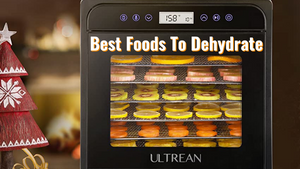Dehydrating food is a great way to save money and time, as well as enjoy a healthier diet. In this article, we are going to take you through the best foods to dehydrate -- from vegetables to fruits and even meat!
Know more things when Dehydrating Foods

Dehydrating foods is a great way to preserve them for longer periods of time. By removing the water content from foods, they become less susceptible to spoilage and bacteria growth. Dehydrated foods also tend to be more lightweight and compact, making them ideal for hiking, camping, and other outdoor activities.
There are many different ways to dehydrate foods, but the most common method is using an electric dehydrator. This appliance uses low levels of heat to remove water from food, without cooking it. Dehydrators come in a variety of sizes and price ranges, so you can find one that suits your needs.
When selecting foods to dehydrate, choose items that are ripe and in good condition. If you're using a dehydrator with multiple trays, it's best to dehydration similar-sized items so they dry at the same rate. Cut food into even pieces before dehydrating to promote even drying.
Once you've selected your food and prepared it for dehydrating, it's time to start the process! Place the food on the dehydrator trays, making sure not to overcrowd them. Set the temperature on your dehydrator according to the manufacturer's instructions, then let it run until the food is dried completely. This can take several hours depending on the type of food and its thickness.
Once your food is fully dried, store it in an airtight container in a cool, dark place. Dehydrated foods will last for several months
How to Dehydrate Foods?

Dehydrating foods is a great way to preserve them for long-term storage. By removing the water content from foods, you can prevent spoilage and extend their shelf life. Plus, dehydrated foods are lightweight and easy to transport, making them ideal for camping and backpacking trips.
To dehydrate foods, you'll need a food dehydrator. This appliance uses low temperatures and airflow to remove water from food. While you can dehydrate foods in an oven or solar oven, a dehydrator will produce better results.
When choosing foods to dehydrate, look for items that are high in water content. Fruits and vegetables are good candidates, as are meats and fish. Avoid items that are already dry or have a high fat content, as these will not dehydrate well.
To get started, slice the food into even pieces no thicker than ¼ inch. If the pieces are too thick, they will take longer to dry; if they're too thin, they may crumble when dehydration is complete. Place the slices on the dehydrator trays and set the temperature according to the manufacturer's directions; most fruits and vegetables should be dried at 125 degrees Fahrenheit.
Dehydration times will vary depending on the type of food and its thickness. thinner slices will dry more quickly than thicker ones. Be sure to check on your food periodically during dehydration; once it's finished, it should be leathery or brittle but still pliable. Allow dried foods
What are The Best Foods for Dehydration?
When it comes to dehydration, it is important to replenish the body with fluids and electrolytes. The best foods for dehydration are those that are high in water content and electrolytes. Watermelons, cucumbers, and tomatoes are all great options as they are over 90% water. Other good choices include oranges, grapefruits, and lemons which are between 80-90% water. For a more complete list of fruits and vegetables that are high in water content, check out this link: https://www.healthline.com/nutrition/20-hydrating-foods#section4
In addition to fruits and vegetables, there are also many other foods that can help hydrate the body. These include coconut water, bone broth, soups, stews, and green juices. Coconut water is an excellent source of electrolytes and is often used as a natural sports drink. Bone broth is also rich in electrolytes and minerals, making it an ideal choice for those who are dehydrated. Soups and stews are also hydrating foods as they contain a lot of liquid. Green juices are another great option as they are packed with nutrients and antioxidants.
Types of food that is best to dehydrated
There are many foods that can be dehydrated, but some are better than others. Here are the best foods to dehydrate:
1. Fruits: Dehydrating fruits is a great way to preserve them for later use. Fruits such as apples, pears, and grapes dehydrate well and make delicious snacks.

2. Vegetables: Dehydrating vegetables is a great way to preserve their nutrients. Vegetables such as carrots, celery, and peppers dehydrate well and can be used in soups or stews.

3. Meats: Dehydrating meats is a great way to preserve their flavor and extend their shelf life. Meats such as beef, chicken, and pork dehydrate well and make excellent jerky or sausage.

4. Fish: Dehydrating fish is a great way to preserve its freshness. Fish such as trout, salmon, and tuna dehydrate well and can be used in soups or stews.

Dehydrating foods is a great way to preserve them for later use. And, it can also be a lot of fun to experiment with different foods to see what they taste like when dehydrated. If you're looking for some ideas on the best foods to dehydrate, then look no further than this list. From fruits and vegetables to meat and seafood, there's something for everyone on this list. So, what are you waiting for? Get started today and see how delicious dehydrated foods can be!


1 comment
Product is terrible and the heating element will fail after only using it 10 times. Customer support offers no help repairing it or replacing it if it fails after the 1 year warranty. Dont purchase a dehydrator from this company.